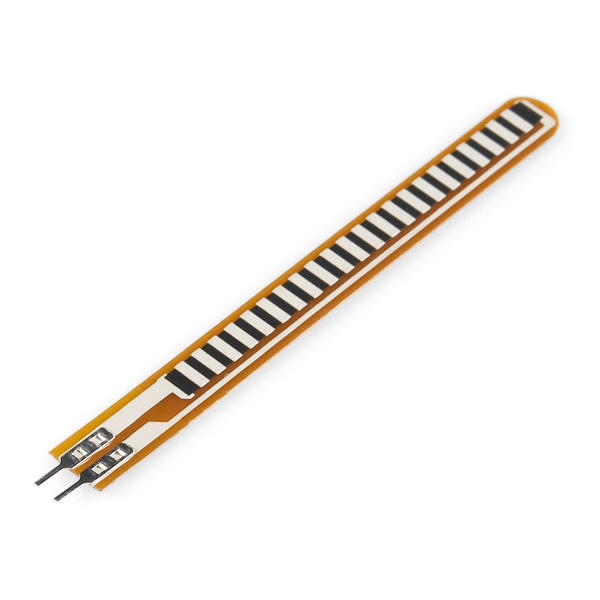I have decided to use the flex sensors in a voltage divider. If you look at the schematic, you will notice that R1 (resistor to Vcc) is 47k, while R2 (resistor to ground) is the flex sensor.
The manual controls are connected to the same I/O pins as the sensors. In the end, the I/O pin is only sensing whether that pin is HIGH or LOW.
That's all I have for now.
- Flex sensor
- test on an actual (indoor) basketball hoop
- make a PCB to get rid of all the clumsy wires
Here is the code
I used an attiny44 @ 8mhz internal, USBtinyISP as the programmer.
//Made by TS Wang
//6/1/2013
//Documentation on this project can be found on http://tswangshotclock.blogspot.com/
/*
This project is meant to further improve Spalding's (r) shot clock.
The problems with that shot clock:
-picks up backboard vibration
-does not pick up net shots
Improvements by this shot clock:
-ignores backboard vibration
-picks up on net shots
-allows manual control from the bench
-manual stop-where-its-at
-manual stop-and-restart
-manual stop (reset)
-manual stop-and-jump-to-zero (if that is useful at all)
This project can be replicated. Replicate all you want.*/
//Attiny44 @ internal rc 8mhz
int latchone = 10; //ST_CP or 12 Last
int clockone = 9; //SH_CP or 11 Second
int dataone = 2; //DS or 14 FIRST
int latchtwo = 3;
int clocktwo = 4;
int datatwo = 5;
int beeper = 6;
int sensor = 7;
int good = 500;
int readstop = 8;
int sec;
byte digitone[11]= {0x00 ,0x30, 0x6D, 0x79, 0x33, 0x5B, 0x5F, 0x70, 0x7F, 0x7B, 0x7E};
void setup() {
pinMode(latchone, OUTPUT); pinMode(clockone, OUTPUT); pinMode(dataone, OUTPUT);
pinMode(latchtwo, OUTPUT); pinMode(clocktwo, OUTPUT); pinMode(datatwo, OUTPUT);
pinMode(beeper, OUTPUT);
pinMode(sensor, INPUT); pinMode(readstop, INPUT);
}
void loop() {reading();}
/*************analog reading***********/
void reading() {
if(digitalRead(readstop) == HIGH) {
spaztwo();
}
if(analogRead(sensor) >= good) {
spaz();
}
else{}
}
/***************countdown and analog reading****************/
void thedeal() {
while (sec >= 0){
countdown(sec);
sec = sec - 1;
for (int i = 0; i<600; i++){ //change this ~ seconds
reading();
compare();
delay(1);
}
}
sec = 24;
}
/****************blink and restart*************/
void spaz() {
sec = 24;
countdown(sec);
digitalWrite(beeper, HIGH);
delay(250);
digitalWrite(beeper, LOW);
delay(250);
digitalWrite(beeper, HIGH);
delay(250);
digitalWrite(beeper, LOW);
delay(250);
sec = 23;
thedeal();
}
/****************blink and stop***************/
void spaztwo() {
if (analogRead(sensor) >= good) {
digitalWrite(beeper, HIGH);
delay(250);
digitalWrite(beeper, LOW);
delay(250);
digitalWrite(beeper, HIGH);
delay(250);
digitalWrite(beeper, LOW);
delay(250);
thedeal();
}
else{spaztwo();}
}
/**************comparing backboard to rim vibration**************/
void compare () {
int backboard = analogRead(0);
int rim = analogRead(1);
if (rim > backboard) {
spaz();
}
else {}
}
/*countdown code*/
void countdown(int NTD) {
switch (NTD) {
case 24:
digitalWrite(latchone, LOW);
digitalWrite(latchtwo, LOW);
shiftOut (dataone, clockone, LSBFIRST, digitone[2]);
shiftOut (datatwo, clocktwo, LSBFIRST, digitone[4]);
digitalWrite(latchone, HIGH);
digitalWrite(latchtwo, HIGH);
break;
case 23:
digitalWrite(latchone, LOW);
digitalWrite(latchtwo, LOW);
shiftOut (dataone, clockone, LSBFIRST, digitone[2]);
shiftOut (datatwo, clocktwo, LSBFIRST, digitone[3]);
digitalWrite(latchone, HIGH);
digitalWrite(latchtwo, HIGH);
break;
case 22:
digitalWrite(latchone, LOW);
digitalWrite(latchtwo, LOW);
shiftOut (dataone, clockone, LSBFIRST, digitone[2]);
shiftOut (datatwo, clocktwo, LSBFIRST, digitone[2]);
digitalWrite(latchone, HIGH);
digitalWrite(latchtwo, HIGH);
break;
case 21:
digitalWrite(latchone, LOW);
digitalWrite(latchtwo, LOW);
shiftOut (dataone, clockone, LSBFIRST, digitone[2]);
shiftOut (datatwo, clocktwo, LSBFIRST, digitone[1]);
digitalWrite(latchone, HIGH);
digitalWrite(latchtwo, HIGH);
break;
case 20:
digitalWrite(latchone, LOW);
digitalWrite(latchtwo, LOW);
shiftOut (dataone, clockone, LSBFIRST, digitone[2]);
shiftOut (datatwo, clocktwo, LSBFIRST, digitone[10]);
digitalWrite(latchone, HIGH);
digitalWrite(latchtwo, HIGH);
break;
case 19:
digitalWrite(latchone, LOW);
digitalWrite(latchtwo, LOW);
shiftOut (dataone, clockone, LSBFIRST, digitone[1]);
shiftOut (datatwo, clocktwo, LSBFIRST, digitone[9]);
digitalWrite(latchone, HIGH);
digitalWrite(latchtwo, HIGH);
break;
case 18:
digitalWrite(latchone, LOW);
digitalWrite(latchtwo, LOW);
shiftOut (dataone, clockone, LSBFIRST, digitone[1]);
shiftOut (datatwo, clocktwo, LSBFIRST, digitone[8]);
digitalWrite(latchone, HIGH);
digitalWrite(latchtwo, HIGH);
break;
case 17:
digitalWrite(latchone, LOW);
digitalWrite(latchtwo, LOW);
shiftOut (dataone, clockone, LSBFIRST, digitone[1]);
shiftOut (datatwo, clocktwo, LSBFIRST, digitone[7]);
digitalWrite(latchone, HIGH);
digitalWrite(latchtwo, HIGH);
break;
case 16:
digitalWrite(latchone, LOW);
digitalWrite(latchtwo, LOW);
shiftOut (dataone, clockone, LSBFIRST, digitone[1]);
shiftOut (datatwo, clocktwo, LSBFIRST, digitone[6]);
digitalWrite(latchone, HIGH);
digitalWrite(latchtwo, HIGH);
break;
case 15:
digitalWrite(latchone, LOW);
digitalWrite(latchtwo, LOW);
shiftOut (dataone, clockone, LSBFIRST, digitone[1]);
shiftOut (datatwo, clocktwo, LSBFIRST, digitone[5]);
digitalWrite(latchone, HIGH);
digitalWrite(latchtwo, HIGH);
break;
case 14:
digitalWrite(latchone, LOW);
digitalWrite(latchtwo, LOW);
shiftOut (dataone, clockone, LSBFIRST, digitone[1]);
shiftOut (datatwo, clocktwo, LSBFIRST, digitone[4]);
digitalWrite(latchone, HIGH);
digitalWrite(latchtwo, HIGH);
break;
case 13:
digitalWrite(latchone, LOW);
digitalWrite(latchtwo, LOW);
shiftOut (dataone, clockone, LSBFIRST, digitone[1]);
shiftOut (datatwo, clocktwo, LSBFIRST, digitone[3]);
digitalWrite(latchone, HIGH);
digitalWrite(latchtwo, HIGH);
break;
case 12:
digitalWrite(latchone, LOW);
digitalWrite(latchtwo, LOW);
shiftOut (dataone, clockone, LSBFIRST, digitone[1]);
shiftOut (datatwo, clocktwo, LSBFIRST, digitone[2]);
digitalWrite(latchone, HIGH);
digitalWrite(latchtwo, HIGH);
break;
case 11:
digitalWrite(latchone, LOW);
digitalWrite(latchtwo, LOW);
shiftOut (dataone, clockone, LSBFIRST, digitone[1]);
shiftOut (datatwo, clocktwo, LSBFIRST, digitone[1]);
digitalWrite(latchone, HIGH);
digitalWrite(latchtwo, HIGH);
break;
case 10:
digitalWrite(latchone, LOW);
digitalWrite(latchtwo, LOW);
shiftOut (dataone, clockone, LSBFIRST, digitone[1]);
shiftOut (datatwo, clocktwo, LSBFIRST, digitone[10]);
digitalWrite(latchone, HIGH);
digitalWrite(latchtwo, HIGH);
break;
case 9:
digitalWrite(latchone, LOW);
digitalWrite(latchtwo, LOW);
shiftOut (dataone, clockone, LSBFIRST, digitone[10]);
shiftOut (datatwo, clocktwo, LSBFIRST, digitone[9]);
digitalWrite(latchone, HIGH);
digitalWrite(latchtwo, HIGH);
break;
case 8:
digitalWrite(latchone, LOW);
digitalWrite(latchtwo, LOW);
shiftOut (dataone, clockone, LSBFIRST, digitone[10]);
shiftOut (datatwo, clocktwo, LSBFIRST, digitone[8]);
digitalWrite(latchone, HIGH);
digitalWrite(latchtwo, HIGH);
break;
case 7:
digitalWrite(latchone, LOW);
digitalWrite(latchtwo, LOW);
shiftOut (dataone, clockone, LSBFIRST, digitone[10]);
shiftOut (datatwo, clocktwo, LSBFIRST, digitone[7]);
digitalWrite(latchone, HIGH);
digitalWrite(latchtwo, HIGH);
break;
case 6:
digitalWrite(latchone, LOW);
digitalWrite(latchtwo, LOW);
shiftOut (dataone, clockone, LSBFIRST, digitone[10]);
shiftOut (datatwo, clocktwo, LSBFIRST, digitone[6]);
digitalWrite(latchone, HIGH);
digitalWrite(latchtwo, HIGH);
break;
case 5:
digitalWrite(latchone, LOW);
digitalWrite(latchtwo, LOW);
shiftOut (dataone, clockone, LSBFIRST, digitone[10]);
shiftOut (datatwo, clocktwo, LSBFIRST, digitone[5]);
digitalWrite(latchone, HIGH);
digitalWrite(latchtwo, HIGH);
break;
case 4:
digitalWrite(latchone, LOW);
digitalWrite(latchtwo, LOW);
shiftOut (dataone, clockone, LSBFIRST, digitone[10]);
shiftOut (datatwo, clocktwo, LSBFIRST, digitone[4]);
digitalWrite(latchone, HIGH);
digitalWrite(latchtwo, HIGH);
break;
case 3:
digitalWrite(latchone, LOW);
digitalWrite(latchtwo, LOW);
shiftOut (dataone, clockone, LSBFIRST, digitone[10]);
shiftOut (datatwo, clocktwo, LSBFIRST, digitone[3]);
digitalWrite(latchone, HIGH);
digitalWrite(latchtwo, HIGH);
break;
case 2:
digitalWrite(latchone, LOW);
digitalWrite(latchtwo, LOW);
shiftOut (dataone, clockone, LSBFIRST, digitone[10]);
shiftOut (datatwo, clocktwo, LSBFIRST, digitone[2]);
digitalWrite(latchone, HIGH);
digitalWrite(latchtwo, HIGH);
break;
case 1:
digitalWrite(latchone, LOW);
digitalWrite(latchtwo, LOW);
shiftOut (dataone, clockone, LSBFIRST, digitone[10]);
shiftOut (datatwo, clocktwo, LSBFIRST, digitone[1]);
digitalWrite(latchone, HIGH);
digitalWrite(latchtwo, HIGH);
break;
case 0:
digitalWrite(latchone, LOW);
digitalWrite(latchtwo, LOW);
shiftOut (dataone, clockone, LSBFIRST, digitone[10]);
shiftOut (datatwo, clocktwo, LSBFIRST, digitone[10]);
digitalWrite(latchone, HIGH);
digitalWrite(latchtwo, HIGH);
break;
}
}
All documents can be found on my Google Drive:
https://drive.google.com/folderview?id=0B5gFDZ2efTDSX0hPdG5sWWJuemc&usp=sharing
Files will be added.
Please ask questions in the comments.
This is the shot clock that will change the game.








